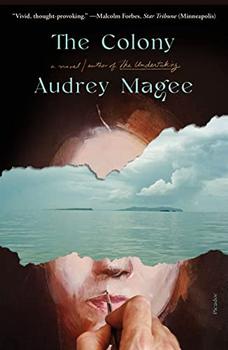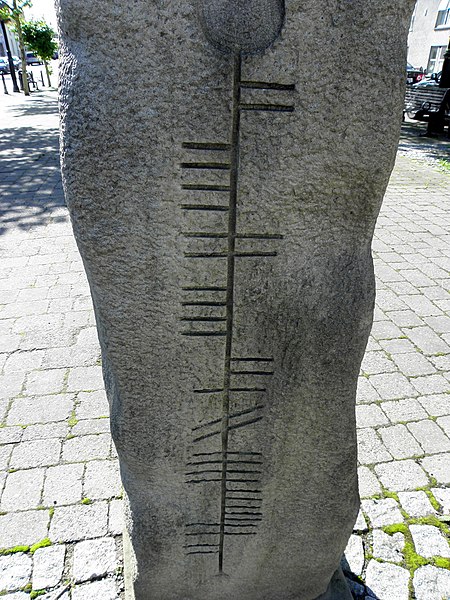Summary | Excerpt | Reviews | Beyond the Book | Read-Alikes | Genres & Themes | Author Bio

A Novel
by Audrey MageeThis article relates to The Colony
 In Audrey Magee's The Colony, one of the characters dedicates his career to salvaging a language that is under threat of extinction: Irish. The source of his research is a multi-generational family, the oldest of whom speaks Irish exclusively, while the youngest is very much Anglicized. This family's linguistic patterns are representative of the continuing decline of the Irish language.
In Audrey Magee's The Colony, one of the characters dedicates his career to salvaging a language that is under threat of extinction: Irish. The source of his research is a multi-generational family, the oldest of whom speaks Irish exclusively, while the youngest is very much Anglicized. This family's linguistic patterns are representative of the continuing decline of the Irish language.
But it wasn't always this way: Irish (or Gaelic, as it is sometimes described) is part of the Celtic language family. The Irish variant developed during the Celtic migrations to Ireland from mainland Europe that took place around 500 BCE.
Written Irish can be traced back to the ogham inscriptions of the 4th century CE. Ogham is sometimes likened to the runic alphabet, consisting of 20 letters composed of lines (notches) on either side of or straddling a continuous line (flesc). These notches would be incised into stone, or sometimes wood. The word "ogham" derives from the Irish warrior-god Ogma — the god of eloquence.
Despite Norse invasion and settlement starting around 800 AD and Anglo-Norse colonization starting in 1169, the Irish language remained dominant in the region until the early 1600s. It was in the 1500s that Irish started to face real threats. First came the Tudor and Stuart conquests and their establishment of plantations (1534-1610); then came the Cromwellian Settlement of 1654 and the Williamite war (1689-91); and finally the Penal Laws of 1695 (these laws meant that Catholics could not enter professions such as law or medicine, hold land or speak the Irish language). This sequence of events heavily impacted the native language. As English became more entrenched as the language of commerce in the towns, Irish became marginalized to the poorer rural areas. When the Penal Laws were relaxed in the mid-1700s, many Irish people still considered English a means of social and economic advancement, thus setting in motion a trend that was to gain momentum. From this, the Irish language became increasingly associated with poverty and deprivation in the collective consciousness. In 1800, the English/Irish language split was roughly balanced — but this was not to last.
Severe acceleration of the Irish language's decline began in the 19th century, in the form of three key historical events: the establishment of English-speaking national schools (set up in 1831), the Great Famine and mass emigration. The famine of the 1840s claimed over one million Irish lives from a population of approximately eight million. Many of the victims were Irish-speaking inhabitants of rural Ireland. This was also a period of mass emigration — largely triggered by famine — to the United States and mainland Britain.
By the end of the 19th century, scholars and the clergy began to realize that Irish was in a vulnerable situation, acknowledging that something of cultural value was at risk of being lost forever. Consequently, the Gaelic League was founded in 1893, aimed at de-Anglicizing the language by promoting the use of Irish in everyday life. Patrick Pearse, League member, famously echoed the sentiments of the organization in the phrase "Tír gan teanga, tír gan an am" ("A country without a language is a country without a soul"). By this point, however, the gravitational pull of English was perhaps irreversible. With the introduction of radio in the 1920s and TV in the 1950s, and with most forms of employment requiring a working knowledge of English, its influence in Irish affairs was indomitable.
Today, Irish is a language that is struggling for survival. The 2011 census encouragingly revealed that 41% of Irish citizens do speak Irish — yet this figure may be somewhat misleading, as this number does not account for degrees of fluency or language use. By 2016, the 2011 figure had fallen to about 30%. While it is difficult to envisage widespread rejuvenation becoming a reality, efforts continue to be made towards revitalization through legislative and social action. It has been reported that the greatest factor determining survival is "intergenerational transmission" — the language risks dying alongside its elderly speakers.
Modern Ogham stone in The Diamond area of Lifford, County Donegal, Ireland. From bottom to top: DONEGAL CO CL (Donegal County Council). Photo by Kenneth Allen (CC BY-SA 2.0)
Filed under Places, Cultures & Identities
![]() This "beyond the book article" relates to The Colony. It originally ran in May 2022 and has been updated for the
June 2023 paperback edition.
Go to magazine.
This "beyond the book article" relates to The Colony. It originally ran in May 2022 and has been updated for the
June 2023 paperback edition.
Go to magazine.
Your guide toexceptional books
BookBrowse seeks out and recommends the best in contemporary fiction and nonfiction—books that not only engage and entertain but also deepen our understanding of ourselves and the world around us.